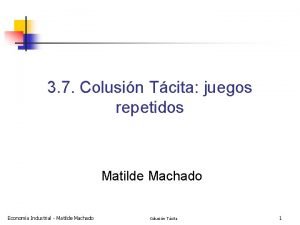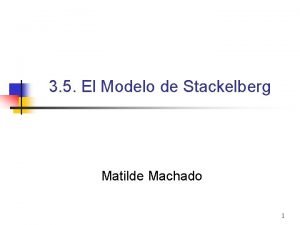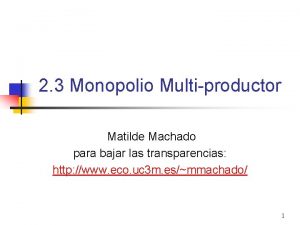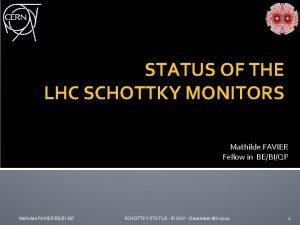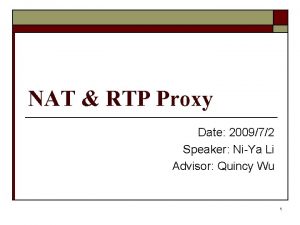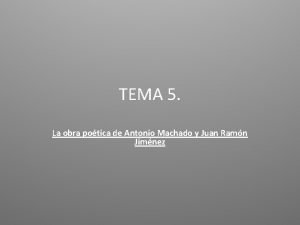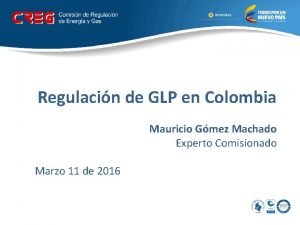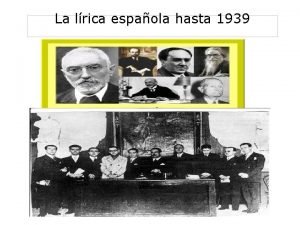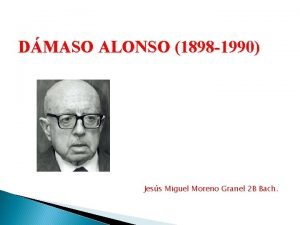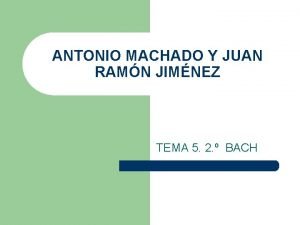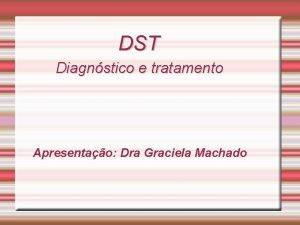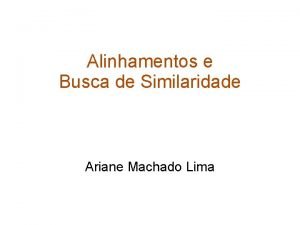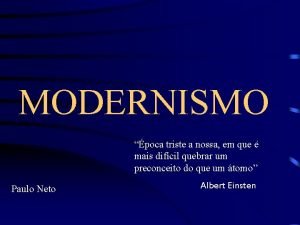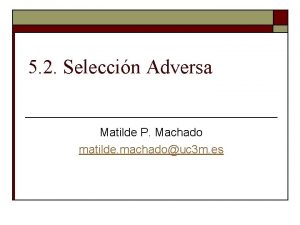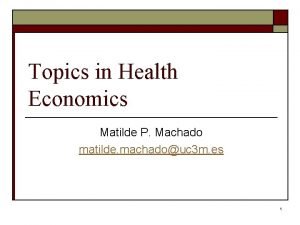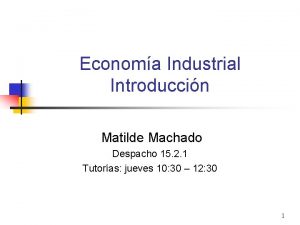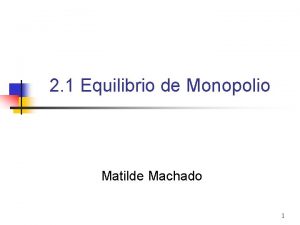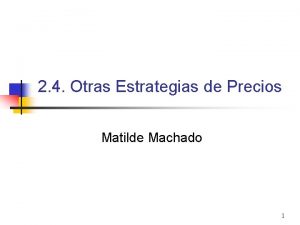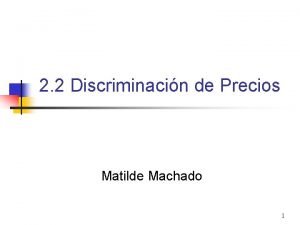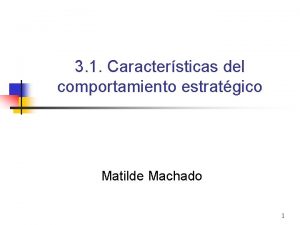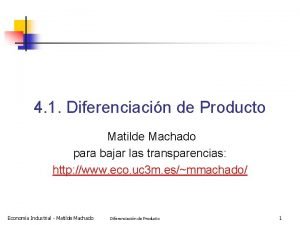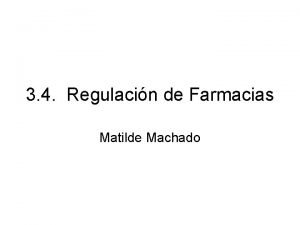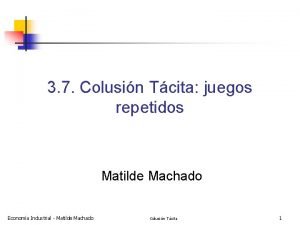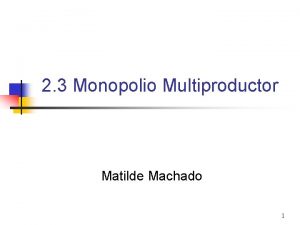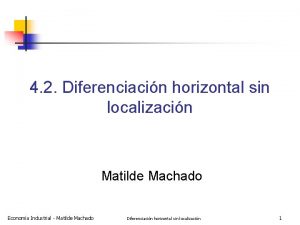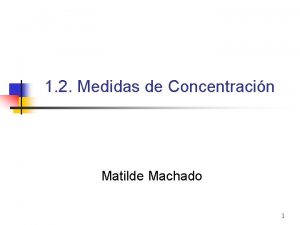Industrial Organization Introduction Matilde Machado Download slides from


![Syllabus of the course 3. Oligopoly 1. Strategic Behavior [Tirole, Introduction until parte II] Syllabus of the course 3. Oligopoly 1. Strategic Behavior [Tirole, Introduction until parte II]](https://slidetodoc.com/presentation_image/3c250689720fd89cb105261ad517ad76/image-3.jpg)
![Syllabus of the course 4. Product Differentiation 1. Definitions [Cabral, Luis 8. 4] 2. Syllabus of the course 4. Product Differentiation 1. Definitions [Cabral, Luis 8. 4] 2.](https://slidetodoc.com/presentation_image/3c250689720fd89cb105261ad517ad76/image-4.jpg)
































- Slides: 36

Industrial Organization Introduction Matilde Machado Download slides from: http: //www. eco. uc 3 m. es/~mmachado/ 1

Syllabus of the course 1. Introduction 1. Concentration Measures [Tirole 5. 5; Cabral 2. 3; Clarke pp 2. 1. 1, 2. 1. 2, Shy 8. 1] 2. Monopoly and Price Discrimination 1. 2. 3. Perfect Competition versus Monopoly Price Discrimination [Tirole 3. 1, 3. 2, 3. 3. ] Other Marketing Strategies [Shy ch. 14] 4. Multiproduct Monopoly [Tirole 1. 1. 2] Industrial Organization - Matilde Machado Introduction 2
![Syllabus of the course 3 Oligopoly 1 Strategic Behavior Tirole Introduction until parte II Syllabus of the course 3. Oligopoly 1. Strategic Behavior [Tirole, Introduction until parte II]](https://slidetodoc.com/presentation_image/3c250689720fd89cb105261ad517ad76/image-3.jpg)
Syllabus of the course 3. Oligopoly 1. Strategic Behavior [Tirole, Introduction until parte II] 2. The Cournot Model [Cabral, Luis 3. 2. , Tirole 5. 4] 3. The Bertrand Model [Cabral, Luis 3. 3, Tirole 5. 1 -5. 2] 4. Price competition with capacity constraints [Cabral, Luis 3. 4, Tirole 5. 3] 5. The Stackelberg Model [Cabral, 3. 5, Segura cap. 5, Shy 6. 2, Church y Ware 13. 2] 6. Entry, Spence-Dixit Model –if time allows [Tirole 8. 1 -8. 2. 2. 1 (except 8. 1. 3), Church y Ware 13. 3] 7. Tacit Colusion: Repeated Games [Tirole 6. 3] Industrial Organization - Matilde Machado Introduction 3
![Syllabus of the course 4 Product Differentiation 1 Definitions Cabral Luis 8 4 2 Syllabus of the course 4. Product Differentiation 1. Definitions [Cabral, Luis 8. 4] 2.](https://slidetodoc.com/presentation_image/3c250689720fd89cb105261ad517ad76/image-4.jpg)
Syllabus of the course 4. Product Differentiation 1. Definitions [Cabral, Luis 8. 4] 2. The Hotteling Model – the linear city [Tirole 7. 1. 1] 5. Basic notes for empirical work Industrial Organization - Matilde Machado Introduction 4

Bibliography: n n n n Luis Cabral “Economía Industrial” Mc. Graw-Hill 1997. Jeffrey Church and Roger Ware “Industrial Organization: A Strategic Approach” Mc. Graw-Hill, 2000. Roger Clarke “Industrial Economics” Blackwell 1999. Roger Clarke “Economía Industrial” Celeste Editores. Oz Shy “Industrial Organization: Theory and Practice” The MIT Press 1996 Jean Tirole “The Theory of Industrial Organization” The MIT Press 1990. Jean Tirole “La Teoría de la Organización Industrial” Editorial Ariel, 1990. Industrial Organization - Matilde Machado Introduction 5

1. Introduction First of all: what is Industrial Organization? Industrial Organization (IO) studies markets (industrial, agriculture and services), in particular those markets that are not perfect i. e. that depart from perfect competition. Industrial Organization - Matilde Machado Introduction 6

1. Introduction What type of questions do we want to answer in IO? Example 1: Is there market power in the pharmaceutical industry? Industrial Organization - Matilde Machado Introduction 7

1. Introduction Example 2: Why do automobile firms keep selling cheap automobiles even when its cost is higher than its price? Brand repetition in last sale Spain 26, 1% France 53, 9% Belgium 50, 8% Industrial Organization - Matilde Machado Introduction 8

1. 1. Concentration Measures In the majority of markets, the level of competition lies between the two extremes of Perfect Competition (minimum concentration) and Monopoly (maximum concentration). Concentration measures offer a simple way to measure the proximity of the competition level of a given market to these two extremes. 2 reasons why concentration measures are useful: Ø To compare different markets (inside and outside the country) Ø To help in market regulation. The regulator needs to assess the level of competition of markets in order to safeguard the consumer’s welfare. Industrial Organization - Matilde Machado Introduction 9

1. 1. Concentration Measures Concentration Indices should be: Ø Easy to compute Ø Independent of the market size Ø Easy to interpret for example if the range is an interval: Perfect Competition Industrial Organization - Matilde Machado Monopoly Introduction 10

1. 1. Concentration Measures Concentration measures are related to concentration curves A concentration curve describes the relation between the accumulated percentage of the total production/sales in the market and the accumulated number of firms in the market ordered according to the firms’ size. Industrial Organization - Matilde Machado Introduction 11

1. 1. Concentration Measures The inequality in firms’ sizes is expressed by the concavity of the concentration curve % production 100 A B Cº D Straight lines = equal size firms (lowest concentration) 0 5 10 20 Nº of firms Market A is the more concentrated; Market D is the least concentrated; The curves B and C lead to an ambiguous classification (market B has less firms but less size inequality). Industrial Organization - Matilde Machado Introduction 12

1. 1. Concentration Measures Hannah and Kay (1977) listed the characteristics that a concentration index should have (notice that the concentration index is a summary of the information contained in the curve): A. B. Classification according to the concentration curve: For example, the index should classify market A as more concentrated than market B. Principle of Transfer of Sales: A transfer of sales from a small firm to a large one should increase the concentration index Industrial Organization - Matilde Machado Introduction 13

1. 1. Concentration Measures C. Entry condition – The entry of a small firm (keeping constant the relative shares of the existing firms) should decrease the concentration index. The opposite in the case of an exit of a small firm. Note: The entry of a sufficient large firm may increase concentration. Ej. Xerox in the photocopy machines market. D. Merger Condition – The merger of 2 or more firms should increase the concentration index since the merger may be decomposed as ≈ Transfer of sales + ↑ concentration Industrial Organization - Matilde Machado exit of the smallest firm ↑ concentration Introduction 14

1. 1. Concentration Measures Examples of Concentration Indices: 1. The inverse of the number of firms = 1. 2. 3. Ideal when all firms in the market are of the same size Only uses information about one point on the concentration curve, the point where the concentration curve crosses the line of 100% accumulated production. Does not satisfy the Hannah and Kay criteria of “transfer of sales” since a transfer of sales (keeping the number of firms constant) does not affect the index. Industrial Organization - Matilde Machado Introduction 15

1. 1. Concentration Measures The Concentration Ratio = Cr - is the sum of the market shares of the largest r firms in the market 2. • • It is easy to compute since we only need information on the r largest firms It is easy to interpret since: Minimum concentration – n equal size firms, si=1/n Industrial Organization - Matilde Machado Introduction Maximum concentration 16

1. 1. Concentration Measures Critics to the Concentration Ratio = Cr : 1. 2. r is arbitrarily chosen Only takes information from 1 point of the concentration curve. For example industries B and C have different ranking depending on the value of r B 100 C r=5 Cr(B)=Cr(C) r<5 Cr(C)>Cr(B) r>5 Cr(B)>Cr(C) 5 Industrial Organization - Matilde Machado Introduction 17

1. 1. Concentration Measures 3. A transfer of sales may not affect the index. The index may take the same value for two industries when in fact one of them is much more concentrated than the other. For example, in the next table, the two industries have the same C 4 but industry 1 is more concentrated than 2. Table 1 s 2 s 3 s 4 s 5 C 4 Industry 1 0. 6 0. 1 0. 05 0. 8 Industry 2 0. 8 Industrial Organization - Matilde Machado Introduction 18

1. 1. Concentration Measures 3. Hirschman-Herfindahl index 1. 2. Takes into account all points of the concentration curve (it is therefore harder to compute since ones needs information on all firms in the market) Satisfies all the criteria of Hannah and Kay H=1 (monopoly) y H=1/n → 0 (for the case of many firms of equal size – perfect competition) Industrial Organization - Matilde Machado Introduction 19

1. 1. Concentration Measures 4. 5. = Equivalent Number (n*), represents the number of equal size firms that would give rise to the same value of the concentration index (H). n* facilitates the interpretation of the concentration index. For example H= 0. 385 n*=2. 59 (this means the market is as concentrated as a market with n* firms of equal size) Gives more weight to larger firms ( in the formula the weight to each market share is the market share). Industrial Organization - Matilde Machado Introduction 20

1. 1. Concentration Measures Table 2 s 1 s 2 s 3 s 4 s 5 s 6 Industry 1 0. 6 0. 1 0. 05 0. 385 Industry 2 0 0. 2 s 7 0 s 8 0 H Contrary to the result obtained using C 4, H shows that industry 1 is more concentrated than industry 2 Industrial Organization - Matilde Machado Introduction 21

1. 1. Concentration Measures Industrial Organization - Matilde Machado Maximum concentration Introduction Minimum concentration 22

1. 1. Concentration Measures Problems with the concentration measures : 1. Cross-ownership – For example the English cement market in 1978. Firm APCM RPC Tunnel Ribblesdale Aberthaw Share 58, 0 16, 5 10, 5 5, 0 Ketton 5, 0 Industrial Organization - Matilde Machado However, APCM had 26% of Aberthaw, Ward had 100% of Ketton and 90% of Tunnel, which was the owner of Ribblesdale. If these share represent the control of firms then. . Introduction 23

1. 1. Concentration Measures The correct reading of the table should be… Firm APCM Ward RPC Share 63, 0 20, 5 16, 5 And the concentration indices would come out very different. Industrial Organization - Matilde Machado Introduction 24

1. 1. Concentration Measures 2. The concentration measures depend on the definition of the relevant market. Ex. Spanish versus European Ex. The US Government had a case against IBM. The US Government claimed that IBM had a dominant position in the mainframe market. In 1983 the market shares in this market were: IBM Burroughs Honeywell NCR Otros Industrial Organization - Matilde Machado 64% 11% 6% 6% 13% Introduction IBM argued that its relevant market was data processing, which included PCs. In this larger market its share was only of 39% 25

1. 1. Concentration Measures Other examples of antitrust cases where the market definition is crucial. Firm Large market Cuota Smaller Market Cuota Dupont (1956) Packaging material <20% Cellophane >75% Philadelphia U. S. A National Bank (1963) <4% Philadelphia 36% Xerox (1975) 65% Plain paper Copy machines >90% Copy machines Industrial Organization - Matilde Machado Introduction 26

1. 1. Concentration Measures Market Definition: n Important in merger or other antitrust cases, economists are called to define the relevant market. n The market definition usually has two components: n n n Geographical Product How the market is defined as we saw usually determines the outcome of antitrust cases. Industrial Organization - Matilde Machado Introduction 27

1. 1. Concentration Measures Product market definition: n n Should include all those goods that are close demand or supply substitutes. Product B is a demand substitute for A if an increase in the price of A causes consumers to demand more B. Product B is a supply substitute for A if, in response to an increase in the price of A, firms that are producing B switch some production to A (increasing the total supply of A). In both cases, the presence of B constraints the pricing of A Industrial Organization - Matilde Machado Introduction 28

1. 1. Concentration Measures Product market definition (cont): First steps in the definition of markets: n n Other things one may do to define a market is to ask people in the industry about rivals and other products Prices of goods in the same market tend to move together (but watch out for exceptions: the prices of two goods not in the same market but that use the same input, say oil, may be highly correlated; and the opposite, two goods that are in the same market but use different inputs may not have a high correlation). Usage of cross price-elasticities, the effect of a rise in 1% in the price of good B in the demand for good A. If cross elasticities are high, then good B is seen as a substitute for A and, therefore, in the same market as A. Industrial Organization - Matilde Machado Introduction 29

1. 1. Concentration Measures Geographic market definition: n The limits are found by checking whether the price in one location affects the price in another location. If so, then both locations are in the same market. Industrial Organization - Matilde Machado Introduction 30

1. 1. Concentration Measures 3. Static measures which do not reflect the evolution of markets over time. For example, if a market has always a dominant firm but this firm is not always the same and in fact changes frequently, it may indeed be a quite competitive market. To measure market stability. Industrial Organization - Matilde Machado Introduction 31

1. 1. Concentration Measures n Market Power: a firm or group of firms has market power if it is profitable to charge a price above the one that would prevail under perfect competition (usually equal to marginal cost). Under this definition most firms have some market power. Hence when courts have a case it means firms have substantial market power for a significant period of time. Unfortunately, the accepted limit over marginal cost is not set, is 5% too much? Or is 10% acceptable? Industrial Organization - Matilde Machado Introduction 32

1. 1. Concentration Measures n n To assess whether price is above marginal cost one has to be able to measure or estimate marginal cost. This is usually hard. Alternatively estimate the price-elasticity of the residual- demand. This summarizes the ability of the firm to raise prices and still keep some of its demand in other words its market power. If the elasticity is high, little market power, if low then a lot of market power. Industrial Organization - Matilde Machado Introduction 33

1. 1. Concentration Measures Let’s do an experiment… Suppose you are a monopolist facing an unknown demand curve. How should you set the optimal quantity…and let’s also see how much market power you have. Excel_spreadsheet_JIOE. xlsx

1. 1. Concentration Measures n Most empirical studies find residual-demand elasticities of no more than 5 or 10, which implies using this formula that price is between 25% and 11% above marginal cost Industrial Organization - Matilde Machado Introduction 35

1. 1. Concentration Measures n In some cases economists can neither estimate marginal costs nor residual demand elasticities. In those cases market shares and concentration measures are used. High market shares are usually taken as evidence of market power (BUT market shares are imperfect indicators of market power). Industrial Organization - Matilde Machado Introduction 36
 Matilde machado
Matilde machado Matilde machado
Matilde machado Multiproductor
Multiproductor Santa matilde
Santa matilde Matilde favier
Matilde favier Grau nomes
Grau nomes Iem projovem
Iem projovem Matilde amato
Matilde amato A small child slides down the four frictionless slides
A small child slides down the four frictionless slides Final energy quick check
Final energy quick check Slides theme download
Slides theme download Slides theme download
Slides theme download Ccna 200-301 ppt slides download
Ccna 200-301 ppt slides download Etapas de machado
Etapas de machado Mauricio gomez machado
Mauricio gomez machado Abf e vaccaro
Abf e vaccaro Es tu boca de rubíes purpúrea granada abierta
Es tu boca de rubíes purpúrea granada abierta Contos e contas ledo vaccaro machado
Contos e contas ledo vaccaro machado En el fondo se ve muchas veces el espinazo de la sierra
En el fondo se ve muchas veces el espinazo de la sierra Etapas de antonio machado
Etapas de antonio machado Colinas plateadas antonio machado
Colinas plateadas antonio machado Etapas de antonio machado
Etapas de antonio machado Allá en las tierras altas por donde traza el duero
Allá en las tierras altas por donde traza el duero Biografia breve de antonio machado
Biografia breve de antonio machado Anoche mientras dormia antonio machado comentario
Anoche mientras dormia antonio machado comentario Ledo vaccaro
Ledo vaccaro Soledades ii antonio machado
Soledades ii antonio machado Poemas de antonio canova
Poemas de antonio canova Ies hnos machado
Ies hnos machado Ricardo zanatta machado
Ricardo zanatta machado Ledo vaccaro machado
Ledo vaccaro machado Erase de un marinero antonio machado
Erase de un marinero antonio machado Ariane machado lima
Ariane machado lima Está en la sala familiar sombría
Está en la sala familiar sombría Modernismo slide
Modernismo slide Gabriela na escola ruth rocha
Gabriela na escola ruth rocha Icarly.com www
Icarly.com www
